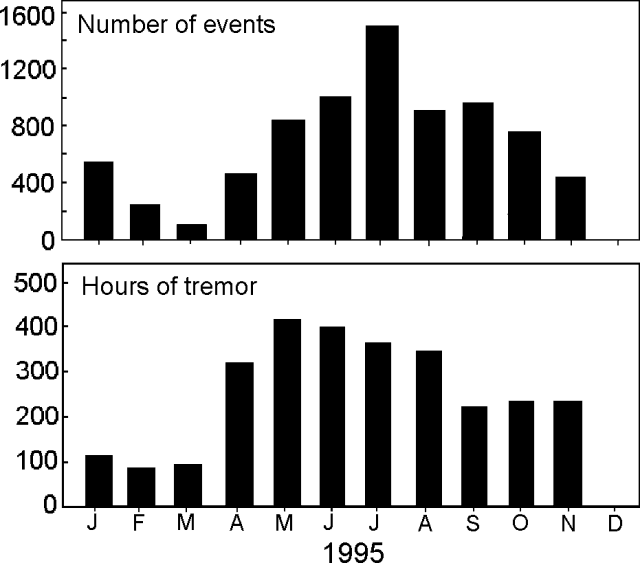Report on Arenal (Costa Rica) — December 1995
Bulletin of the Global Volcanism Network, vol. 20, no. 11 (December 1995)
Managing Editor: Richard Wunderman.
Arenal (Costa Rica) Explosive activity increase from October; lava flows continue
Please cite this report as:
Global Volcanism Program, 1995. Report on Arenal (Costa Rica) (Wunderman, R., ed.). Bulletin of the Global Volcanism Network, 20:11. Smithsonian Institution. https://doi.org/10.5479/si.GVP.BGVN199512-345033
Arenal
Costa Rica
10.463°N, 84.703°W; summit elev. 1670 m
All times are local (unless otherwise noted)
October plumes rose as high as 1 km above Crater C. During the second week of November explosive activity increased, growing both in terms of the number of outbursts and the overall quantity of tephra emitted. Blocks and bombs landed above 1,000 m elevation. Ash columns rose over 1 km and blew over the NW, W, and SW flanks. Windows vibrated in buildings 6.5 km E (La Fortuna).
A lava flow first emitted in July remained mobile; one arm reached 860 m and another reached 900 m elevation. A new flow began at the end of the month, venting from a point S of the vent for the previous month's flow, and moving SW. Re-established vegetation in the zone of lava flows continued to degrade due to acid rain.
For the frequency range below 3.5 Hz, there were 765 events during October and 444 seismic events during November (figure 74). These events chiefly occurred associated with Strombolian eruptions; some were of sufficient amplitude to reach station JTS, 30 km from the active crater. The largest number recorded in a single day was 40 (on 5 November). During October and November, 2.1-3.5 Hz tremor took place for about 232 and 238 hours, respectively (figure 74). On 15 and 17 November tremor prevailed for 21 and 20 hours, respectively.
 |
Figure 74. Arenal seismicity and tremor for 1995 (recorded at station "VACR," 2.7 km NE of the main crater). Courtesy of OVSICORI-UNA. |
Geological Summary. Conical Volcán Arenal is the youngest stratovolcano in Costa Rica and one of its most active. The 1670-m-high andesitic volcano towers above the eastern shores of Lake Arenal, which has been enlarged by a hydroelectric project. Arenal lies along a volcanic chain that has migrated to the NW from the late-Pleistocene Los Perdidos lava domes through the Pleistocene-to-Holocene Chato volcano, which contains a 500-m-wide, lake-filled summit crater. The earliest known eruptions of Arenal took place about 7000 years ago, and it was active concurrently with Cerro Chato until the activity of Chato ended about 3500 years ago. Growth of Arenal has been characterized by periodic major explosive eruptions at several-hundred-year intervals and periods of lava effusion that armor the cone. An eruptive period that began with a major explosive eruption in 1968 ended in December 2010; continuous explosive activity accompanied by slow lava effusion and the occasional emission of pyroclastic flows characterized the eruption from vents at the summit and on the upper western flank.
Information Contacts: E. Fernandez, E. Duarte, R. Saenz, W. Jimenez, and V. Barboza, Observatorio Vulcanologico y Sismologico de Costa Rica, Universidad Nacional (OVSICORI-UNA), Apartado 86-3000, Heredia, Costa Rica.

